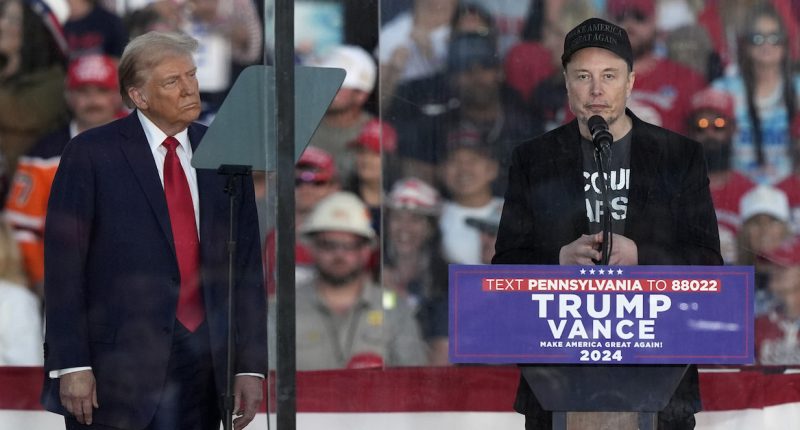
President Donald Trump listens as Elon Musk speaks during a campaign rally at the Butler Farm Show, Saturday, Oct. 5, 2024, in Butler, Pa. (AP Photo/Julia Demaree Nikhinson, File).
A San Francisco judge on Friday blocked the Trump administration from moving forward with ambitious plans to reorganize the federal government and fire large swaths of federal workers.
In a 42-page order, U.S. District Judge Susan Illston, a Bill Clinton appointee, granted a temporary restraining order requested by a coalition of labor unions, nonprofit groups, and municipalities.
The underlying litigation challenges President Donald Trump‘s Feb. 11, executive order: “Implementing The President’s ‘Department Of Government Efficiency’ Workforce Optimization Initiative.” The order purports to “commence” a “critical transformation of the Federal bureaucracy” by “eliminating waste, bloat, and insularity.”
In real terms, Trump’s plans would have administrative agency heads quickly “initiate large-scale reductions in force” (RIFs), or massive layoffs, in service of the goal to restructure the government.
On Friday, the court pumped the brakes on those efforts.
Love true crime? Sign up for our newsletter, The Law&Crime Docket, to get the latest real-life crime stories delivered right to your inbox.
In the 115-page original petition, the plaintiffs allege various separations of powers violations – arguing Trump’s order unconstitutionally oversteps into areas reserved for Congress. The complaint also alleges numerous violations of the Administrative Procedure Act (APA), the broad statute governing agency actions.
The court, in issuing the temporary pause on firing, said the plaintiffs were likely to succeed on “at least some” of their claims.
“It is the prerogative of presidents to pursue new policy priorities and to imprint their stamp on the federal government,” Illston muses. “But to make large-scale overhauls of federal agencies, any president must enlist the help of his co-equal branch and partner, the Congress.”
In the present case, however, the court expressed severe misgivings with how the Trump administration tried to achieve its aims.
One of the key problems, Illston observed, was tasking three agencies and offices – the Office of Personnel Management (OPM), the Office of Management and Budget (OMB), and the Department of Government Efficiency (DOGE) – with most of the heavy lifting. In the litigation, the plaintiffs single out specific memos by OPM and OMB and the widely-publicized – and often self-trumpeted – actions undertaken by DOGE as “unconstitutional and unlawful orders” as part of what they referred to as Trump’s “radical transformation.”
The court finds that neither OPM nor OMB have any statutory authority to terminate employees – aside from their own internal employees – “or to order other agencies to downsize” or to restructure other agencies. And, as far as the Elon Musk-led agency is concerned, the judge is withering: “As plaintiffs rightly note, DOGE ‘has no statutory authority at all.””
“In sum, no statute gives OPM, OMB, or DOGE the authority to direct other federal agencies to engage in large-scale terminations, restructuring, or elimination of itself,” Illston writes. “Such action is far outside the bounds of any authority that Congress vested in OPM or OMB, and, as noted, DOGE has no statutory authority whatsoever.”
The judge also finds a broader problem with Trump’s order.
“Plaintiffs are likely to succeed on their claim that the President’s Executive Order 14210 is ultra vires, as the President has neither constitutional nor, at this time, statutory authority to reorganize the executive branch,” Illston goes on.
To hear the plaintiffs tell it, Trump vastly “exceeded any constitutional authority granted to him” by trying to fire so many federal workers. The plaintiffs also say there is no law passed by Congress that offers any such authority either. In turn, the lawsuit alleges the 45th and 47th president “usurped” congressional powers as outlined in the U.S. Constitution.
The court tends to agree – and suggests it’s an easy call.
“As history demonstrates, the President may broadly restructure federal agencies only when authorized by Congress,” the order continues. “The simple proposition that the President may not, without Congress, fundamentally reorganize the federal agencies is not controversial: constitutional commentators and politicians across party lines agree.”
The court goes on like this:
[W]hat plaintiffs allege—and what defendants fail to refute—is that Executive Order 14210 reaches so broadly as to exceed what the President can do without Congress. The Executive Order mandates that “Agency Heads shall promptly undertake preparations to initiate large-scale reductions-in-force (RIFs), consistent with applicable law,” including submitting plans that “shall discuss whether the agency or any of its subcomponents should be eliminated.” This is not an instance of the President using his “inherent authority to exercise general administrative control of those executing the laws,” because Congress has passed no agency reorganization law for the President to execute. Congress may choose to do so. But as of today, Congress has not.
The government, for their part, argued Trump did not expressly order any of the firings himself and that the agencies were just issuing guidance. The judge rejected this defense.
“The evidence plaintiffs have presented paints a very different picture: that the agencies are acting at the direction of the President and his team,” Illston continues. “Defendants submitted no evidence of their own in response.”
As for the APA claims, the court largely held off on issuing findings – saying a factual record needed to be developed on most of them. Still, the judge found the plaintiffs were likely to succeed on two APA claims that have to with exceeding authority and acting too swiftly without public comment.
Immediately after the district court’s order, the Trump administration filed notice of their intent to appeal the ruling to the 9th Circuit.




